|
|
|||
|
(Back to Preceding Week; on to Next Week) |
|
|
|
VIEWS OF A BUTTONBUSH,
AND POLLINATORS, TOO No matter your political persuasion, if you enjoy nature you'll have to agree the U.S. Senate did something good recently in declaring the week of 24-30 June 2007 as "National Pollinator Week." There's no doubt pollination is worth celebrating, for if there were no pollinators we humans--and the rest of nature--would be in a heap of trouble. Without birds and bees and bats and beetles and other pollen-pushing creatures, many flowers would go unfulfilled--never to produce nuts, berries, seeds, and other fruits that enable animals of the world to survive. To commemorate the Senate's recognition--and in support of the North American Pollinator Protection Campaign--we went out with camera this week at Hilton Pond Center in search of pollinators. We found plenty of them and hope you'll read on for our distant and close-up views of a fascinating little shrub called Buttonbush--and its pollinators, too.
All text & photos © Hilton Pond Center Buttonbush is a semi-aquatic woody shrub that grows not around Hilton Pond specifically but is on our property along the banks of a larger impoundment into which Hilton Pond flows. This unnamed lower body of water--which we informally call "Nothilton Pond"--differs from its upper neighbor in that vegetation along its margins has been uncut for perhaps 50 years, whereas previous owners mowed right to the edge of Hilton Pond.
We stopped such clear-cutting practices at the Center back in 1982, after which natural succession brought new plants to Hilton Pond's banks--especially Hazel Alder and, in the past several years, wildflowers such as Swamp Milkweed. As yet, however, Buttonbush hasn't made the jump upstream.
We discovered our lower pond Buttonbush colony several years ago when numerous spherical seed heads that give the deciduous shrub its name were silhouetted against the autumn sky. By now--late June--the shrubs are full of leaves and blooms, each branch bearing dark green foliage and at least one white golf-ball-sized inflorescence. We find these clusters of flowers attractive from a distance and increasingly more fascinating the closer we look.
Buttonbush's scientific name, Cephalanthus occidentalis, means "western headflower," referring to its occurrence in the Western Hemisphere (there are related species in Asia) and to the dozens of individual blossoms on its spherical "head-shaped" flower cluster. Buttonbush--normally up to ten feet tall--occurs in nearly all states east of the Great Plains but thrives in the Southeast, where it occasionally surpasses shrub height to become a 45-foot tree.
Also called "Honeyballs" because of its flower fragrance, Buttonbush is in the Madder Family (Rubiaceae), one of the largest plant families with more than 500 genera and 7,000 species worldwide. Fellow family members found in the Carolinas include Partridge-Berry, Bluets, and Bedstraw, but surprisingly enough the most familiar relative is a native of the Middle East . . . the Coffee tree.
Most members of the Madder Family bear "four-part" flowers, with four sepals, four petals, and four stamens--all visible in the Buttonbush photo above. In Buttonbush, the sepals are mint green, the petals creamy white, and the stamens dark and tipped in yellow when the pollen is ripe. If a viable pollen grain sticks to the Buttonbush flower stigma, it produces a pollen tube that snakes its way down the pistil stalk to its base, where the ovary awaits. It is here that fertilization actually occurs. In the case of Buttonbush there are two ovules, so each of the multitude of flowers in the inflorescence produces two hard brownish seeds or nutlets that ripen in late autumn and are disseminated when they fall on the water and float away.
In the photo above, most of Buttonbush's white blossoms have turned brown and detached from the flower head, revealing an expanse of four-angled green sepals at their bases. The flowers' ovaries are hidden within these sepals. Also notice the elongated tan-colored spots on the flower stem; these are lenticels, believed by most botanists to function in bark and stem respiration.
Buttonbush is seldom found away from water and can grow with its roots permanently inundated (right), often forming dense monocultures on pond margins or along slow-moving streams. These thickets provide nesting sites for many water-loving songbirds such as Yellow Warblers and Common Yellowthroats. Potential nest predators are undoubtedly deterred because Buttonbush shrubs seem to have no shortage of prickly, broken-off dead twigs among the more pliable live ones. White-tailed Deer are known to browse Buttonbush foliage and green twigs as high as they can reach, Other than chainsaws, about the only things controlling growth of Buttonbush are American Beavers that chew through the stringy bark (left) and fire that burns the shrubs to water level--a cataclysmic event from which the Buttonbush seems to rebound quickly and with improved vigor. (Buttonbush is often an early successional plant on lake margins after major fires.) Although ranchers typically try to eliminate Buttonbush from around farm ponds, some folks grow it as an ornamental because of the attractiveness of its flower; landscapers also like the plant because its blossoms do indeed draw in a bevy of equally attractive pollinators, as we discovered this week at Hilton Pond--or, more accurately, down at Nothilton Pond.
To get some of the photos in this week's installment, we had to place a six-foot stepladder partway into the pond and then climb it to the five-foot height of the best Buttonbush blossoms. Astride the ladder we came face to face with the spherical flowers and dozens of orange-and-black-and-white creatures we recognized as moths that are both diurnal and nocturnal. These colorful half-inch insects were Ailanthus Webworm Moths, Atteva punctella (above), a NATIVE species now found more commonly on Ailanthus--an INTRODUCED tree from Asia. Its mosaic-like forewings are diagnostic, although the hindwings are black. Bees were also well-represented among the various insects we found visiting our Buttonbushes. In light of recent outcry about declines in populations of European Honey Bees, Apis mellifera, we were pleased to see sizeable numbers of this busy little insect lapping up nectar (above left). There also were several larger, darker, long-bodied bees (below right) that turned out to be Giant Resin Bees, Megachile sculpturalis, an Asian species that first showed up in the Carolinas in the mid-1990s and has since spread across the Southeast. It's interesting we saw no recognizable Bumblebees or Carpenter Bees, nor any of the smaller native bees, wasps, or flies. (A half-inch Hoverfly passed through, sat on a leaf, but did not visit any Buttonbush flowers.) We thought at first we simply missed these common insects, but upon further reflection it may be their mouthparts are just too small or improperly shaped to plumb the depths of narrow and relatively long Buttonbush corollas.
We spent the better part of two hours just watching the pollination parade on the Buttonbushes, but we never did observe one of the organisms mentioned in a couple of references: All text & photos © Hilton Pond Center POSTSCRIPT: The North American Pollinator Protection Campaign is a collaborative effort by universities, government agencies, non-profit organizations, professional groups, and other entities to make the public aware of the importance of pollinators. Through their efforts the U.S. Postal Service on 29 June 2007 issued a panel of four pollinator stamps (left). Comments or questions about this week's installment?
Thanks to the following fine folks for recent gifts in support of Hilton Pond Center for Piedmont Natural History and/or Operation RubyThroat: The Hummingbird Project. Your tax-deductible contributions allow us to continue writing, photographing, and sharing "This Week at Hilton Pond." (Please see Support if you'd like to make a gift of your own.)
IMPORTANT NOTE: If you ever shop on-line, you may be interested in becoming a member of iGive, through which nearly 700 on-line stores from Barnes and Noble to Lands' End will donate a percentage of your purchase price in support of Hilton Pond Center and Operation RubyThroat. We've just learned that for every new member who signs up and makes an on-line purchase within 45 days iGive will donate an ADDITIONAL $5 to the Center. Please sign up by going to the iGive Web site. It's a painless and important way for YOU to support our work in conservation, education, and research. "This Week at Hilton Pond" is written & photographed You may wish to consult our Index of all nature topics covered since February 2000. You can also use our on-line Hilton Pond Search Engine at the bottom of this page. For a free, non-fattening, on-line subscription to |


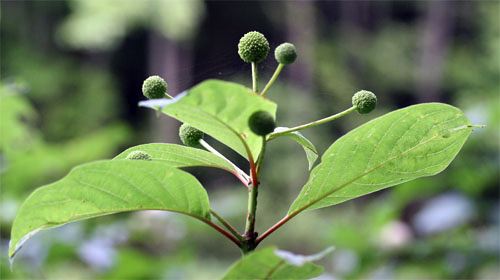
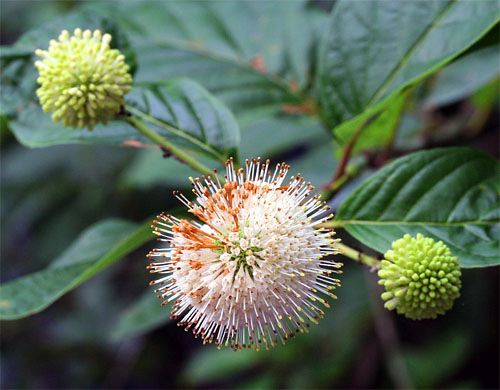
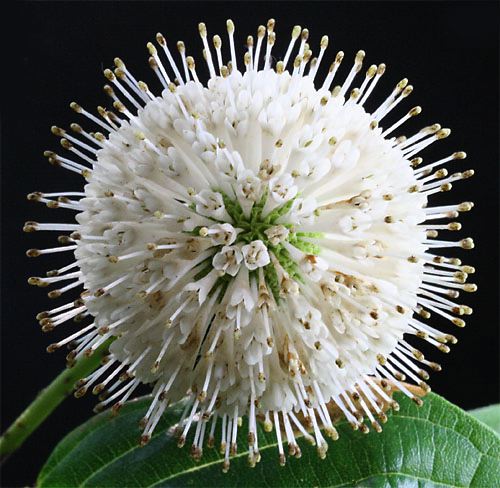
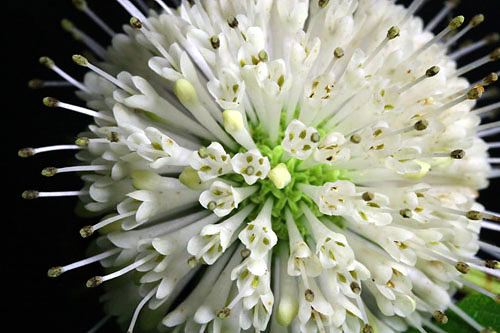
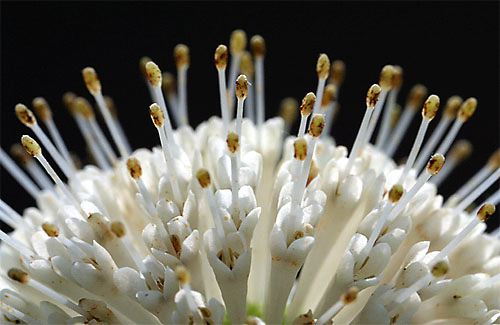
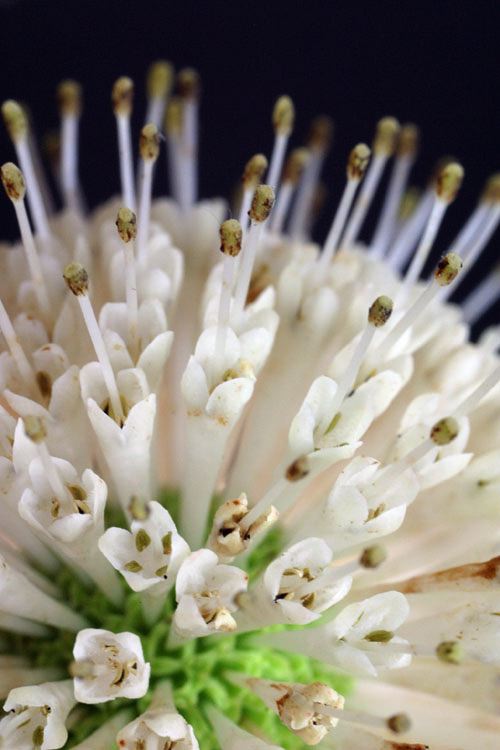
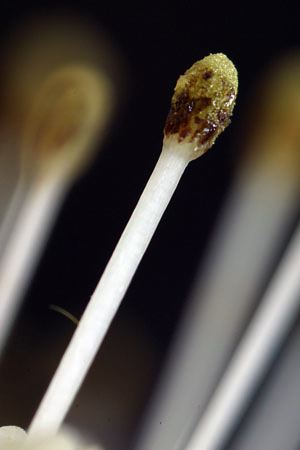 Each flower has only one pistil (left), an elongated, almost translucent white structure with a brownish club--the stigma--on the top end. The pistil protrudes at least a quarter inch outside the petals, which themselves form a tube about three-eighths of an inch in length. The stigma, coated with a sticky substance, takes on a yellowish cast when pollen is deposited thereupon by any of many pollinators that visit Buttonbush.
Each flower has only one pistil (left), an elongated, almost translucent white structure with a brownish club--the stigma--on the top end. The pistil protrudes at least a quarter inch outside the petals, which themselves form a tube about three-eighths of an inch in length. The stigma, coated with a sticky substance, takes on a yellowish cast when pollen is deposited thereupon by any of many pollinators that visit Buttonbush.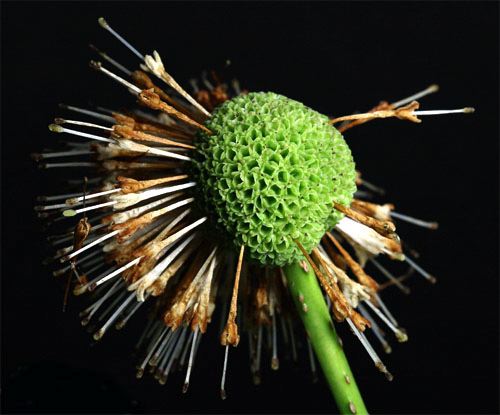
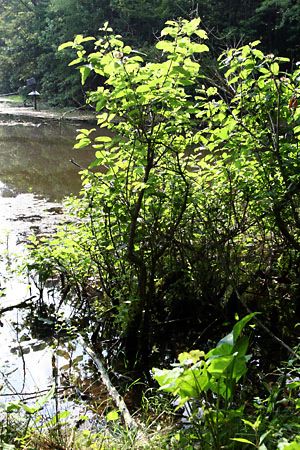 The elliptical four-inch leaf of Buttonbush is a dark, lustrous green above, slightly paler below, with a pink petiole attaching it to the twig. (Some populations of Buttonbush have leaves with slightly fuzzy undersides.) Oddly, even on the same shrub some leaves are opposite, while others are in whorls of three. Flower stalks arise from leaf axils, primarily on the current year's twig growth.
The elliptical four-inch leaf of Buttonbush is a dark, lustrous green above, slightly paler below, with a pink petiole attaching it to the twig. (Some populations of Buttonbush have leaves with slightly fuzzy undersides.) Oddly, even on the same shrub some leaves are opposite, while others are in whorls of three. Flower stalks arise from leaf axils, primarily on the current year's twig growth.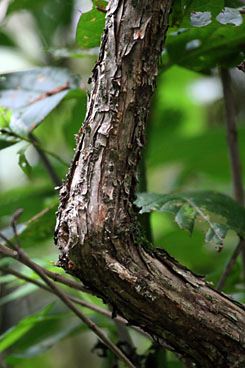 so it's curious the leaves are reportedly poisonous to domesticated livestock. Waterfowl such as Mallards, Wood Ducks, and teal dine on Buttonbush seeds.
so it's curious the leaves are reportedly poisonous to domesticated livestock. Waterfowl such as Mallards, Wood Ducks, and teal dine on Buttonbush seeds.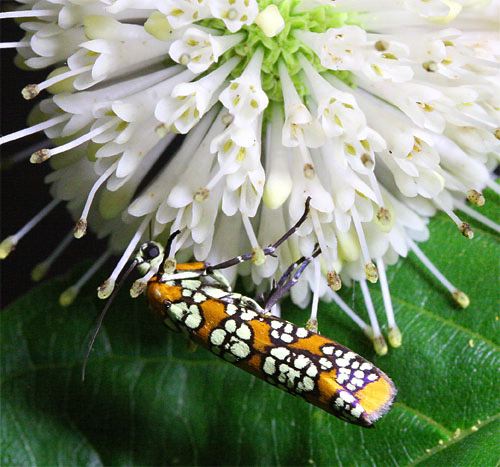
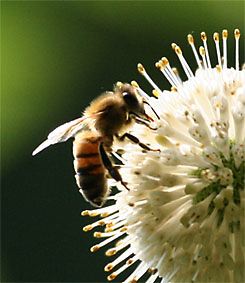 If you look carefully at the photo, you can see the moth's thin, black proboscis probing one of the Buttonbush flowers. As we watched these moths feed, we noted they typically probed each individual flower twice before moving on to the next. (NOTE: The original larval host plant for Ailanthus Webworm was Paradise Tree, Simarouba glauca, native to South Florida and the Neotropics and in the same family--the Simaroubaceae--as Ailanthus altissima.)
If you look carefully at the photo, you can see the moth's thin, black proboscis probing one of the Buttonbush flowers. As we watched these moths feed, we noted they typically probed each individual flower twice before moving on to the next. (NOTE: The original larval host plant for Ailanthus Webworm was Paradise Tree, Simarouba glauca, native to South Florida and the Neotropics and in the same family--the Simaroubaceae--as Ailanthus altissima.)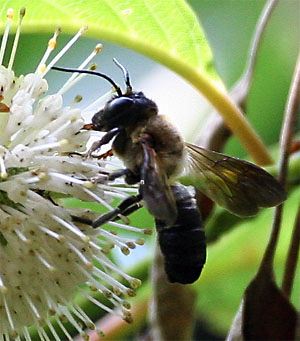 These industrious imports were practically bumping into each other as they scrambled for the flowers' sweet treat. A few other paper wasps (Polistes sp., below left) were foraging beneath Buttonbush leaves, but they likely were more intent on gleaning spiders than gathering nectar or doing any pollinating.
These industrious imports were practically bumping into each other as they scrambled for the flowers' sweet treat. A few other paper wasps (Polistes sp., below left) were foraging beneath Buttonbush leaves, but they likely were more intent on gleaning spiders than gathering nectar or doing any pollinating.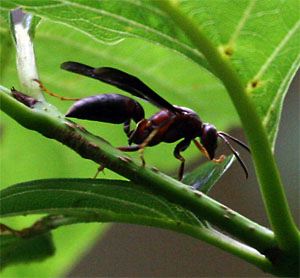 While we watched this menagerie of pollinators, a few even larger insects began to flutter in. We identified them as Silver-spotted Skippers, Epargyreus clarus (below right), a common butterfly around Hilton Pond. Like moths and bees on the Buttonbush blossoms, these skippers seemed ALMOST oblivious to us and our camera as we tried to capture images. (That said, we must admit we had to use our telephoto lens because the skippers did skip out when we got too close with the macro.)
While we watched this menagerie of pollinators, a few even larger insects began to flutter in. We identified them as Silver-spotted Skippers, Epargyreus clarus (below right), a common butterfly around Hilton Pond. Like moths and bees on the Buttonbush blossoms, these skippers seemed ALMOST oblivious to us and our camera as we tried to capture images. (That said, we must admit we had to use our telephoto lens because the skippers did skip out when we got too close with the macro.)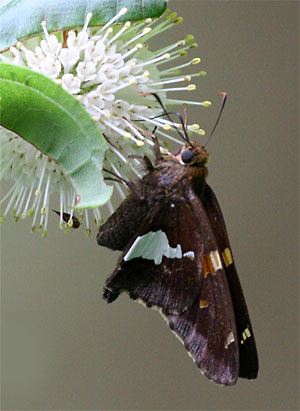 The Ruby-throated Hummingbird. Hummers are reported to visit Buttonbushes, but we can't imagine the shrub's tiny flowers would provide much nectar for a ruby-throat. More likely the hummingbirds are preying upon the smaller, unidentified insects we saw creeping and crawling among Buttonbush flowers. In any case, any hummer visiting Buttonbush blossoms undoubtedly would do the shrubs a favor, using its relatively large bill to displace pollen grains and--like all the insects we spotted--thereby being worthy of mention during National Pollinator Week 2007.
The Ruby-throated Hummingbird. Hummers are reported to visit Buttonbushes, but we can't imagine the shrub's tiny flowers would provide much nectar for a ruby-throat. More likely the hummingbirds are preying upon the smaller, unidentified insects we saw creeping and crawling among Buttonbush flowers. In any case, any hummer visiting Buttonbush blossoms undoubtedly would do the shrubs a favor, using its relatively large bill to displace pollen grains and--like all the insects we spotted--thereby being worthy of mention during National Pollinator Week 2007.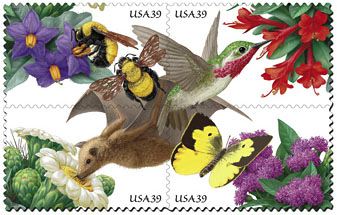 Depicted by artist Steve Buchanan are four native pollinators: Calliope Hummingbird, Morrison's Bumblebee, Lesser Long-nosed Bat, and Southern Dogface butterfly, shown pollinating four native wildflowers: Purple (Chaparral) Nightshade, Hummingbird Trumpet, Prairie (Common) Ironweed, and Saguaro cactus. (Each stamp has a 41-cent denomination, not the 39-cent one shown here.) For information about the North American Pollinator Protection Campaign--for which Hilton Pond Center is proud to be a partner--visit their Web sites at
Depicted by artist Steve Buchanan are four native pollinators: Calliope Hummingbird, Morrison's Bumblebee, Lesser Long-nosed Bat, and Southern Dogface butterfly, shown pollinating four native wildflowers: Purple (Chaparral) Nightshade, Hummingbird Trumpet, Prairie (Common) Ironweed, and Saguaro cactus. (Each stamp has a 41-cent denomination, not the 39-cent one shown here.) For information about the North American Pollinator Protection Campaign--for which Hilton Pond Center is proud to be a partner--visit their Web sites at 

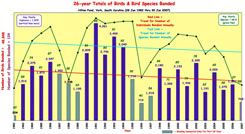
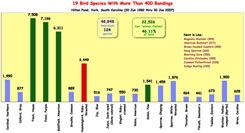
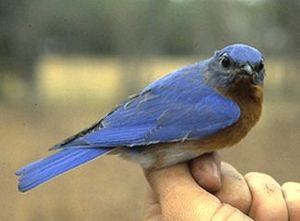
 Please report your
Please report your
